Rough-In Installation
Rough InInstallation
In this chapter you will learn about
- Structured wiring rough-in installation procedures
- Cabling and building standards
After the electricians and plumbers complete their work installing the electrical lines and plumbing in the open walls of a new home, a structured wiring project can proceed with the installation of the cabling, and placement of the distribution panel and outlet boxes. This phase of the project is commonly referred to as the rough-in phase because after this work is completed, the dry wall installers come in and put the wallboard up. Following this step, the next phase of the structured wiring project – trim-out (see Chapter 8) – can be performed.
This chapter focuses on the steps performed during the rough-in phase of a structured wiring project, which is primarily include locating the distribution panel, locating the outlet boxes or mud rings, and pulling cable through the wall studs, headers, joists, and floors.
Rough in Preparation
Using the information developed in the planning phase of the project (see Chapter 6), you should have a very good estimate of the amount of cabling and outlets required for the project. You should also be able to determine the best type and size of distribution panel for the home.
Outlets
The National Electric Code (NEC) requires all residential wiring be inside an electrical box (see Figure 7-1) whenever it connects to a receptacle, switch, fixture, or another wire. This practice is also good for low-voltage connections, such as Cat 5, coaxial, and twisted pair cabling.
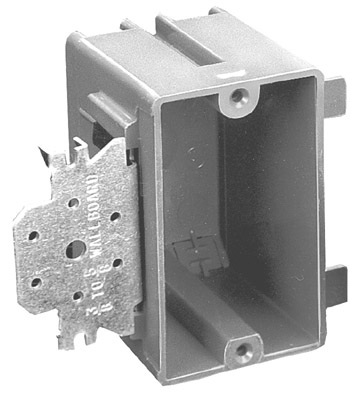
Figure 7-1: An electrical outlet box.
Photo courtesy of Lamson & Sessions.
Structured Wiring Outlet Boxes
The best place to begin the rough-in process is by mounting either outlet boxes or mud rings around the house in their designated locations. Deep or backless low-voltage brackets, such as those shown in Figure 7-2, are sometimes referred to as mud rings and are a good choice for use with communications and structured wiring.
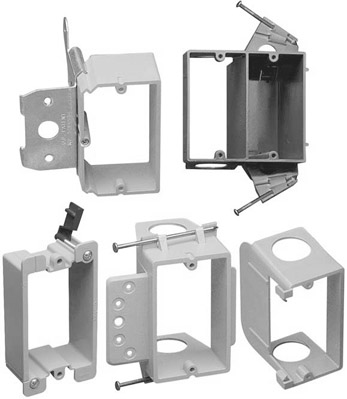
Figure 7-2: An assortment of low voltage brackets.
Photo courtesy of Lampson & Sessions.
As shown in Figure 7-3, double-gang boxes are also available that can be used to combine electrical (110 volt) and structured wiring (low voltage) at the same location. The box features a center divider, which is required by the NEC for dual-purpose boxes, and prevents crosstalk and electrical interference from reaching the low-voltage (structured wiring) side of the box.
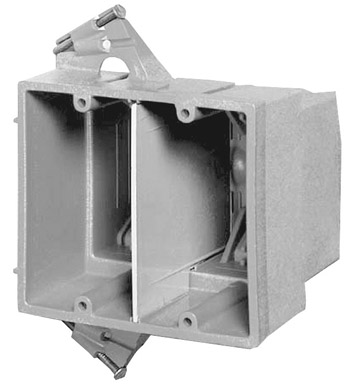
Figure 7-3: A double-gang box used to mount both electrical and structured wiring in a single location.
Photo courtesy of Lampson & Sessions.
There are also “sidecar” brackets (see Figure 7-4) that allow a low voltage outlet to be attached to an electrical outlet. Sidecar brackets go around and over a standard electrical box. After the faceplate is installed, the two boxes give the appearance that the electrical and low voltage outlets are in a common two-gang box.
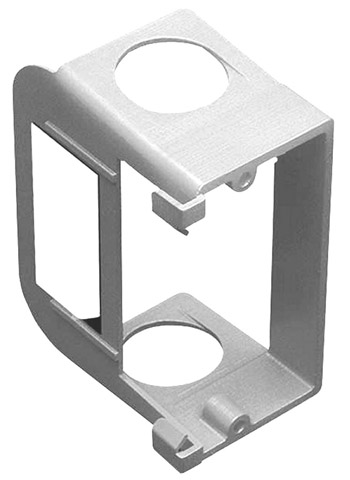
Figure 7-4: A sidecar bracket allows a low voltage box to be attached to the side of an electrical outlet box.
Photo courtesy of Lampson & Sessions.
| Note |
It is common practice to use blue outlet boxes for AC or high-voltage connections and orange boxes for structured wiring and low-voltage connections. |
Installing Outlet Boxes and Brackets
Outlet boxes are secured to a wall stud by either nailing them to the inside edge of a stud (as shown in Figure 7-5) or by screwing them to the face of a stud. If the building is using steel studs, the wall box will have to be fastened with screws.
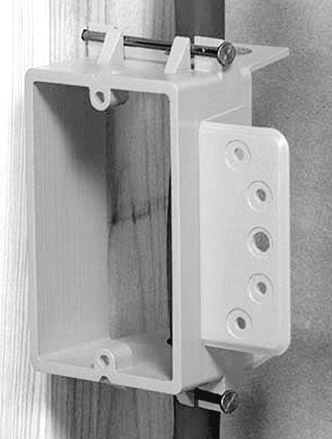
Figure 7-5: An outlet box nailed to a wall stud.
Photo courtesy of Lampson & Sessions.
The front edge of the outlet box or bracket should extend beyond the stud so that it will be flush with the front surface of the drywall when it’s installed. Most outlet boxes have a raised line or mark for where the front of the stud should be. Once the drywall is in place, you can cut out only a portion of the wall to access the outlet box or bracket, so be sure of your measurements before you nail or screw the box in place.
Outlet boxes that are to support data or video connectors should be placed so that the bottom of the box or bracket is at the same height from the floor as the electrical boxes on the same wall and should be in the range of 12 to 16-inches from the floor.
Outlet boxes or brackets that will support volume controls, wall telephones, or other types of local units should be placed at the same height as any light switch boxes on the same wall and should be between 46 to 48-inches above the floor.
| Note |
If the job requires the use of floor-mounted boxes, be sure you use outlet boxes specifically manufactured for that purpose to overcome any bend radius issues inside the floor joists. |
Don’t take the term rough-in too literally. Take the time to line up the outlet boxes or brackets so that they are straight. A box or bracket that is not aligned will result in a faceplate that isn’t straight on the wall.
Ceiling Installation
Some ceiling mounted devices (and wall mounted speakers) either come with a rough-in kit or have one available. This kit contains either a mud ring or a mounting ring, like the one shown in Figure 7-6 provides a template for the drywall to be cut for the speaker. The speaker is then attached during trim out. Be sure to leave enough wire to allow for easy installation of the device at trim-out.

Figure 7-6: A rough-in mounting bracket for a speaker.
Photo courtesy of Crutchfield New Media, LLC.
Pre Wiring
During the pre-wire or when locating speakers during trim-out that didn’t have speaker brackets, the cabling or wire should be installed using a zigzag pattern between the wall studs, as illustrated in Figure 7-7. The cable should be stapled loosely to the studs so that the staples can be easily removed during trim-out by lightly tugging on the cable.
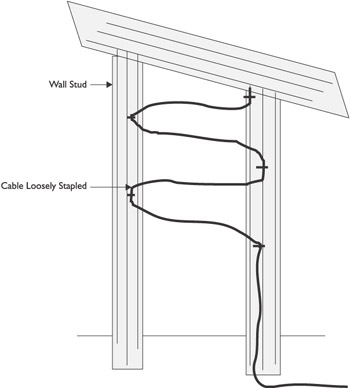
Figure 7-7: Zigzag wiring between wall studs during pre-wire.
It’s a good idea to photograph the placement of the cabling during pre-wire to show a reference point, such as a door or window corner, to aid in locating the cable behind the drywall during trim-out.
Distribution Panel
The distribution panel in a structured wiring system, like the empty one shown in Figure 7-8, interconnects all of the external communications lines, such as television, telephone, and Internet, with the interior structured wiring running throughout a home. Inside the distribution panel, each incoming signal is divided and, in most cases, amplified before being sent out on the structured wiring throughout the home.

Figure 7-8: An open design distribution panel into which the control units for a home’s systems can be mounted.
Photo courtesy of Smarthome, Inc.
If the distribution panel for the structured wiring system is housed in an in-wall or flush-mounted box, the mounting box (without components) should be installed during rough-in. They are made to fit easily between standard stud dimensions on 16-inch centers. Otherwise, the installation of the panel can be delayed until the trim-out phase when the panel will be surface mounted. Locate the panel at about eye-height, similar to the height of the electrical panel. If multiple panels are installed, they should be side-by-side on the same level with conduit between them inside the wall for interconnectivity.
During rough-in, the location of the distribution panel must be decided and set permanently so that the structured cable runs have a starting point. There are two methods that can be used to install the cable during rough in:
- A cable run can be started at an outlet location and pulled back to the distribution panel.
- Cable can be pulled from the distribution panel toward the outlet boxes.
Be sure and label each wire as you begin pulling so that when you reach the distribution panel or destination room you know where each wire goes. Leave at least a 2-foot length of extra cable at the outlet and at least 3 feet at the distribution panel (or better yet, let it hang and touch the floor) to enable termination of the cable during trim out.
| CROSS-REFERENCE |
The details of connecting structured wiring into the distribution panel are covered in Chapters 7 and 8. |
Cable Rough In
The process used to install cable is very different in a new construction situation than it is in a remodel or retrofit situation:
- In new construction, the walls are open and you have complete access to the wall studs, headers, and joists to create a pathway for the cable; and you can plainly see any obstacles in the walls that may later cause system performance issues.
- In a remodeling situation, with the walls closed, your best bet is often to minimize the unknown problems in the walls and install the cabling in the attic, basement, or crawl space under the floor wherever possible.
In either case, the guidelines for installing, handling, and routing the structured wiring cable remains the same. These guidelines are specific to each type of structured wiring cable and are discussed in the following sections.
| CROSS-REFERENCE |
See Chapters 1 and 2 for more information on individual cables and their installation requirements. |
Structured Wiring Bundles
Several manufacturers offer pre-bundled structured wiring cable that can be installed as a single set. Like the bundle shown in Figure 7-9, these cable bundles come in a variety of individual cables to satisfy the cable requirements of virtually every structured wiring requirements. At minimum, commercial structured cabling bundles include two runs each of Cat 5e (or better) and RG-6 coaxial cable. However, higher-end bundles may also include fiber optic cabling (included for future-proofing a home).
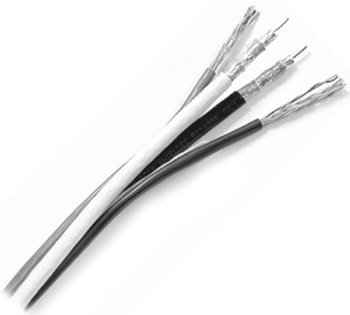
Figure 7-9: A commercially available structured wiring bundle.
Photo courtesy of Belden Inc.
Structured wiring bundles are typically wrapped with a twist wrap, with an attachment method called “banana peel,” such as the one shown in Figure 7-9, or a with a flexible outer jacket to improve their pull-ability. At the point where the outer wrapping needs to be removed to route individual wires to outlets or controls, the binding is easily removed by cutting or a pull-string.
“Bonded” bundled cable is also available and makes individual cable preparation easy. In a bonded cable, the outer sheathing is attached to the shielding layer, which is attached to the insulation around the inner conductors. The benefit of bonded cable is that it is highly waterproof and is a more rugged cable.
Audio Cable
Audio cable is typically made up of two or four stranded wires of 16-gauge or larger wire. There are no standard color-coding schemes for audio wiring, but in most cases, one wire can be distinguished from the other by its jacket color, markings, ridges or other jacket features. In some cables, one conductor wire may be copper-colored and the other silver-colored. The ability to tell one conductor from another in the audio cable is important because this allows you to ensure the polarity of its connections.
During rough-in, audio cabling home runs can be pulled starting at the control amplifier or equipment and toward the speakers and controls in each room or zone. Multiple cables can be pulled together to an area of the house and then branch off separately to their designated room locations. Cables can also be pulled from the room locations, and merged together as they leave an area of the house and head back to the equipment. Remember to label all wiring per the wire chart.
Cable should also be pulled to all volume control, keypad, and speaker locations with a service loop of extra cable length (about 2 feet) provided at the volume control/keypad location. One way to reduce the task of pulling speaker wiring during rough-in is to install a multiple conductor cable to service more than one speaker. Each speaker requires two conductors and if a 4-conductor cable is pulled into a room, two conductors can be routed to each speaker location. This allows a single pull of cable to service the two speakers instead of pulling two 2-conductor cables by just pulling the cable to the first speaker and then looping it on to the second speaker.
Coaxial Cable
Some controversy exists as to which type of coaxial cabling is best for video distribution. Some prefer the more rigid and less flexible RG-6 while others prefer the flexible and more easily installed RG-59. RG-6 has become the preferred coaxial cable of residential system installers because of its ability to handle a wider range of RF channels. In either case, coaxial cabling should be chosen to match the application in use, per the system manufacturer’s specifications. Remember that different sized coaxial cable, single-braid coaxial cable and quad-shield types of coaxial cable require different types of terminators and connectors.
| CROSS-REFERENCE |
See Chapter 1 for guidelines on installing coaxial cable. |
Coaxial cabling, of either specification, is easily pulled through walls, open or closed. However, you should avoid tight bends or kinks in the cabling because they can change the impedance of the cable and this can lead to signal loss.
Category 5e Cable
The current standards for data networking cabling in business (EIA/TIA 568) and homes (EIA/TIA 570) call for Category (Cat) 5 or Cat 5e cabling, respectively. This four-pair twisted-pair cable is available as shielded (STP), screened (ScTP), or unshielded (UTP) cable. The most commonly used cabling for residential installations is UTP cable.
UTP cabling is also the cable type most often included in structured wiring bundles. For areas where this cabling must be installed nearer to potential interference sources, such as fluorescent lighting fixtures or electrical motors, ScTP or STP would be a better choice than UTP.
The handling guidelines for installing category cabling are:
- Install the cable so that there are no kinks or sharp bends that can cause performance problems.
- Limit the pulling tension to 25 pounds or less (per EIA/TIA 568).
- Pull cables slowly and use constant pressure.
- Don’t pinch or crush the cable by stepping, sitting, or setting any object on it. Also don’t use grasping tools, such as pliers or vise grips at the end, to pull the cable.
- Avoid pulling cable over protruding nails or sharp edges that may damage the outer jacket/insulation of the cable.
- If cable lubricant is used, be sure that it is not harmful to the cable’s outer jacket material.
- Ensure that no cable home run is longer than 90 meters (295 feet) from the distribution panel.
- In metal studs, use plastic grommets in the holes to protect the cable jacket and don’t pull category cable through a metal stud with an electrical line passing through it.
- If a cable breaks, don’t splice the cable; instead, pull a new clean run.
- Don’t pull category cable through the same hole in a stud or wall as the electrical wiring.
Cable Management
The orderly arrangement of all cabling in a residential installation is not only for aesthetic reasons, but it can simplify maintenance, troubleshooting, and later additions to the system.
Cable management begins in the placement of the cabling. The standards permit running cable over ceiling joists, but in longer open spaces, it may be better for the safety of the cable and its performance to use some form of cable management.
Here are a few guidelines for the use of cable management devices.
- Cable staplesAlthough most types of staples should not be used, if staples are the only choice available for securing a cable in place, avoid crushing or compressing the cable. There are curved staples available that are made for securing bundled cables and are designed to avoid these problems. The use of plastic standoff cable staples should be used instead of metal staples; and staple guns should never be used.
- Cable tiesCable ties should be applied loosely and spaced randomly. Over-tightening cable ties may crush the cable and damage its interior wires. Crush-proof cable ties are available and Velcro cable ties are an even better choice over nylon or plastic cable ties. To use a cable tie as a cable hanger, the cable tie can be stapled or nailed to a stud or joist to hold a cable bundle in place. Figure 7-10 illustrates how cables can be bundled using cable ties.
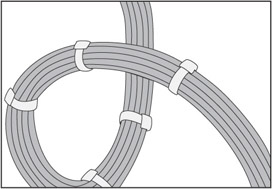
Figure 7-10: Cable ties are used to bundle cables together. - Cable traysWhen longer open spaces must be crossed by long runs of cable, the use of a cable tray prevents sag in the cable and helps keep the cable out of harm’s way. Refer to the EIA/TIA 569A standard for the guidelines for installing cable trays. Figure 7-11 illustrates the use of a cable tray.
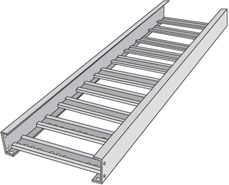
Figure 7-11: A ladder style cable tray can be used to bridge large amounts of cable across open spaces. - ConduitFlexible structured wiring conduit is available that provides ample room to pull even structured wiring cable bundles through (see Figure 7-12).
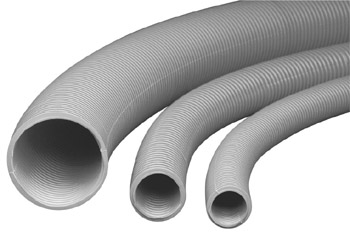
Figure 7-12: Flexible residential structured wiring conduit.
Photo courtesy of Lampson & Sessions.
- J-hooksThis cable management device (see Figure 7-13) can be used in lieu of cable trays across long open runs. Avoid using “wedding band” or “bridle ring” cable supports because they can be over-tightened and crush the cable.
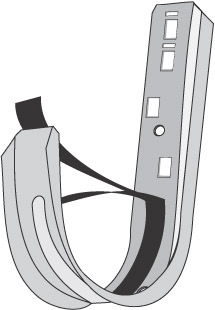
Figure 7-13: A J-hook cable management device with a built-in Velcro cable tie.
Pull Cords
In some situations, especially when not enough time is available to pull the cabling in the walls of a new construction project or should the cable not be available when this step must be performed, installing a pull-cord instead of the actual cable is a faster way to go. A pull-cord is a stiff cord that can be placed through the cable path and later used to pull the structured wiring cable into place. Although a pull-cord can be used to install structured wiring, whenever possible, it’s always best to pull the actual cable.
However, there are a few downsides to using pull-cords:
- Additional stepUsing a pull-cord adds an additional step and additional time to the project; time you may not always have.
- Cable pathPull-cords are typically limited to pulling a structured wiring bundle into a cable path that runs in a straight-line. Structured wiring bundles are relatively stiff and if there are any bends or sharp turns in the cable path the cable can get stuck. Another problem may exist if the cable path wasn’t sized properly for the size of the cable bundle as it is always thicker than the pull-cord.
- Pull-cord breakageThere are commercially available pull-cords that are stronger than just using heavy twine, but all pull-cords can, and do, break on occasion. If the pull-cord breaks, the only way to correct the problem is to cut open a wall and repair the cord.
Cabling for New Construction
The cable guidelines that apply to new construction situations (in addition to those listed previously) are:
- Route cabling along joists to minimize the number of holes drilled through wall studs.
- Any holes drilled through a stud, header, footing, or joist should be large enough to accommodate all cables to be pulled to a location.
- Cable runs through a stud must be 1.25 inches or more from the nearest edge of the board. This allows for a maximum of a 1.25-inch hole in a standard 2 x 4 stud. If that distance cannot be met, the board must be reinforced with a metal plate or bushing that is at least 0.0625 inches thick. This requirement doesn’t apply to cabling placed in conduit.
- Cable that is run through a metal stud (without conduit) must be protected by a bushing or grommet in hole.
- Label each cable run as it is pulled; label both the cable and the outlet box to coincide with the wire chart prepared in the planning phase of the project.
Cabling for Retrofit
Several obstacles exist for installing structured cabling in an existing home, including outside walls filled with insulation, horizontal cross-members in walls, and the lack of pre-existing pathways through wall studs.
One solution is to install the cabling in the attic, placing the cabling in J-hooks or attached to the rafters with cable ties. Another is to pull the cabling underneath the house in a basement with an open ceiling or in the crawlspace under the house. On some homes, the only choice may be to run the cabling on the exterior of the home. Other solutions include using commercially available cable raceways – some styles can be used in front of or to replace wall baseboards.
Review
The NEC requires that all residential electrical wiring be inside an electrical box wherever it connects to a receptacle, switch, fixture, or another wire and this is considered to be a good practice for low voltage structured wiring as well.
To begin the rough-in process, mount the low-voltage outlet boxes or brackets throughout the home. Outlet boxes or brackets are secured to a wall stud by either nailing them to the inside edge of a stud or by screwing them to the face of a stud. If the building is using steel studs, the wall box will have to be fastened with screws. The front edge of the outlet box or bracket should extend beyond the stud so that it will be flush with the front surface of the drywall when it’s installed. Most ceiling and wall-mounted devices have rough-in kits available that contain a rough-in mounting bracket.
The distribution panel interconnects external communications lines to interior structured wiring. Inside the distribution panel, incoming signals are divided and distributed to the structured wiring. If the distribution panel for the structured wiring system is housed in an in-wall or flush-mounted box, the mounting box should be installed during rough-in. Otherwise, the installation of the panel will be surface mounted and can be delayed until the trim-out phase. During rough-in, the location of the distribution panel must be decided and set permanently.
Several manufacturers offer pre-bundled structured wiring cable that can be installed as a single cable pull. These cable bundles usually include two runs each of Cat 5e and RG-6 coaxial cable. Higher-end bundles may include an additional two runs of fiber optic cabling.
During rough-in, audio cabling home runs should be pulled starting at the control amplifier and toward the speakers and controls in each room or zone. A service loop of cable should be placed at each end of the cable. Coaxial cabling is easily pulled through walls, but tight bends or kinks in the cabling should be avoided. All cabling should be labeled during rough-in per the wire chart. The EIA/TIA and NEC standards require certain handling rules for installing Cat 5e cabling.
Cable management is important for more than aesthetic reasons. It can simplify maintenance, troubleshooting and later additions to the system. Options available for mounting cable include special cable staples, cable ties, cable trays, conduit, and J-hooks.
Questions
- Which national standard requires that all residential wiring be inside an electrical box wherever it connects to a receptacle, switch, fixture, or another wire?
- EIA/TIA
- NEC
- IEEE
- UL
- What is the recommended length of the service loop that should be provided at the distribution panel for each cable run during rough in?
- 6-inches
- 1 foot
- 2 feet
- 3 feet or to the floor
- What is the generally accepted color for low-voltage or structured wiring outlet boxes?
- Blue
- Green
- Orange
- Yellow
- Which two of the following best describe how far data or video connector outlets should be placed above a floor?
- At the same height of any electrical switches on the same wall
- At the same height of any electrical outlets on the same wall
- 12 to 16-inches above the floor
- 46 to 48-inches above the floor
- Which two of the following best describe how far volume controls and wall telephone outlets should be placed above a floor?
- At the same height as any electrical switches on the same wall
- At the same height as any electrical outlets on the same wall
- 12 to 16 inches above the floor
- 46 to 48 inches above the floor
- Which structured wiring device interconnects external communications lines to interior structured wiring?
- Distribution panel
- Multiplexer
- Outlet box
- Patch panel
- What cable sets are typically included in a structured wiring cable bundle?
- Two runs of RG-59 or RG-6 and one run of Cat 5e
- One run of RG-59 or RG-6 and two runs of Cat 5e
- Two runs of RG-59 or RG-6, one run of fiber optic, and two runs of Cat 5e
- Two runs of RG-59 or RG-6 and two runs of Cat 5e
- Which one of the following is not a guideline for installing category cable?
- Limit pulling tension to 25 pounds or less.
- Lubricants should be safe for the cable’s outer covering.
- No cable runs can exceed 90 meters.
- If a cable breaks, splice the cable using standard connectors.
- Which one of the following should not be used when installing structured wiring cable?
- Velcro cable ties
- Nail gun
- Cable trays
- Conduit
- What is the type of coaxial cabling preferred by most home system designers and technicians?
- RG-6
- RG-59
- RJ-45
- 10Base5
Answers
- B. Each of the standards organizations listed in the other choices have similar standards or recommendations, but the NEC rules.
- D. Service loops of 3 feet should be provided at the distribution panel end of a cable and 2 feet should be provided at the outlet end of a cable during rough-in to facilitate installation activities during trim out.
- C. Blue is typically used for electrical wiring and green and yellow are rarely used, if ever.
- B and C. Connector outlets should match up with electrical outlets on the same way.
- A and D. Outlets that will support controls or wall-mounted telephones should line up with the wall switches on the same wall.
- A. Okay, so this was an easy one—as well it should be.
- D. I’m sure cable bundles are available that may contain the other combinations listed, but two runs each of coaxial and category cable are standard for structured wiring cabling.
- D. If a cable breaks, splice the cable using standard connectors. No splices; no splices; and no splices. Got it?
- B. Because they can pierce a cable, nail and most staples should be avoided. If you absolutely must use staples, use the type designed for bundled cabling or the plastic standoff type.
- A. Because of its ability to carry multiple signals and frequencies, RG-6 has largely replaced RG-59 in home systems.
Part I - Home Technology Installation Basics
- Wire and Cable Basics
- Connector Types and Uses
- Wiring Installation Practices
- Codes, Standards, and Safety Practices
Part II - Structured Wiring
- Infrastructure Wiring Basics
- Planning a Structured Wiring Installation
- Rough-In Installation
- Trim-Out Installation
- Troubleshooting Structured Wiring
Part III - Home Computer Networks
- Computer Network Basics
- Computer Network Hardware
- Computer Network Software
- Designing and Installing a Computer Network
- Troubleshooting a Home Network
Part IV - Audio/Video Systems
- Distributed Audio System Basics
- Designing and Installing Distributed Audio Systems
- Distributed Video Basics
- Designing and Installing Distributed Video Systems
- Troubleshooting Audio Systems
- Troubleshooting Video Systems
Part V. Home Lighting Management Systems
- Home Lighting Basics
- Home Lighting Devices
- Designing a Home Lighting Control System
- Installing a Home Lighting Control System
- Troubleshooting and Maintaining Lighting Control Systems
Part VI - Telecommunications
- Home Communication System Basics
- Designing and Installing a Home Telephone System
- Troubleshooting a Home Communication System
Part VII - HVAC and Water Management
Part VIII - Security System Basics
- Security System Basics
- Designing a Home Security System
- Installing a Home Security System
- Troubleshooting and Maintaining a Home Security System
- Home Security Surveillance Systems
- Home Access Control Systems
Part IX - Home Technology Integration
- Defining Users Needs and Desires
- User Interfaces
- Home Automation Controllers
- Programming
- Integrating the Connected Home
- Other Home Technology Integration Devices
Part X - Appendices
EAN: N/A
Pages: 300
- Article 354 Nonmetallic Underground Conduit with Conductors Type NUCC
- Article 356 Liquidtight Flexible Nonmetallic Conduit Type LFNC
- Article 388 Surface Nonmetallic Raceways
- Tables 12(A) and 12(B)
- Example No. D2(b) Optional Calculation for One-Family Dwelling, Air Conditioning Larger than Heating [See 220.82(A) and 220.82(C)]
